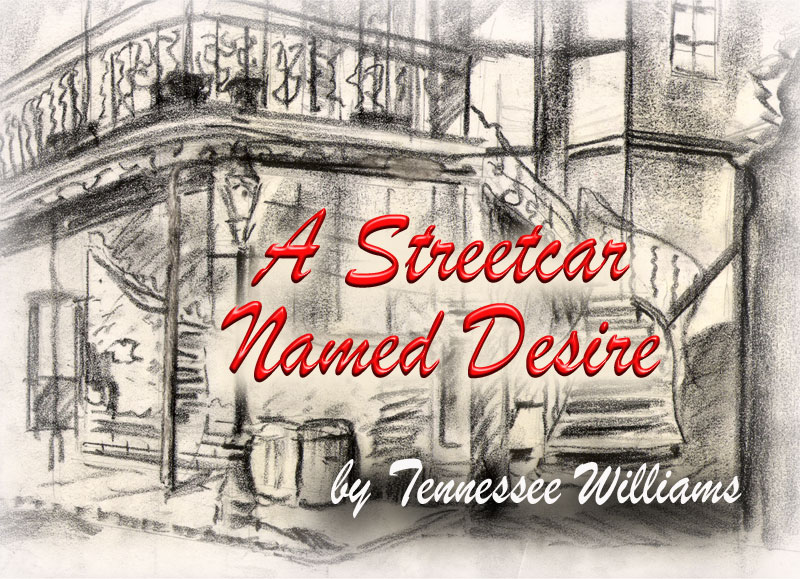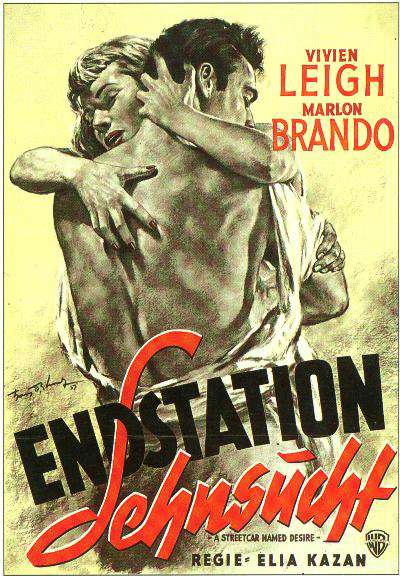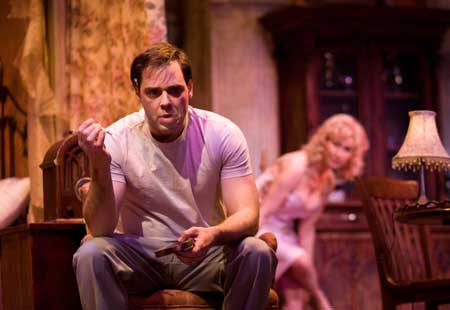1. Blanche DuBois is the first lady of the American stage.
Whereas the motion picture of Tennessee William’s A Street Car Named Desire draws attention to Brando’s gritty portrayal of Stanely Kolwalski, it seems as though Williams intended Blanche Dubois, played with gravitational pull by Susan Riley Stevens, to hold center stage for playhouse productions. The production was all of three hours long, which can be demanding even for the most ardent theater-lovers, but Stevens entertained, intrigued and beguiled effortlessly for the entire production, and could have done so longer. And this was no small feat. Stevens delivered more than three-fourths of the total lines spoken during the production, not to mention that most of hers were in the  form of delirious confabulations that would drive any relatively sane person batty. My hat goes off to Stevens for a stellar performance. STELLAR! Sorry, had to.
form of delirious confabulations that would drive any relatively sane person batty. My hat goes off to Stevens for a stellar performance. STELLAR! Sorry, had to.
2. The Marlon Brando doppelganger effect.
Of course, whoever plays Stanley Kowalski will linger in the shadow of Brando’s iconic performance until he has proven himself. Jeffrey Coon’s Stanley was realistically violent, volatile, chauvinistic, and almost never without a cig or beer in hand. His portrayal of Stanley adopted more fervent expressions of aggression and subsequent penitence than Brando’s, particularly noted when Coon lets fly Stanley’s indelible cri de coeur, “STELLA!” Theatergoers might be taken aback by Coon’s seemingly unbridled outbursts that send dishes and fists flying. Despite America’s inordinate romance with Brando’s portrayal of Stanley, I could easily countenance an equally rewarding romance with Coon.
STELLAR: Jeffrey Coon as Stanley Kowalski and Susan Riley Stevens as Blanche DuBois
3. It’s the verisimilitude, stupid!
Weathered stone tenements rising amid other telltale derelictions are the illuminated urban scars of New Orleans’ French Quarter of the late 1940s. I know this because every ripped lace curtain, every blemish on the facades of the tenements, every gaudy gold bangle and string of Mardi Gras beads seemed meticulously hand-picked, as if half the production’s preparation was restoring the French Quarter’s dingy glory. I might as well have asked for a hot gourd from the vendor perambulating about the stage during one particular scene change; and he might have actually given me one!
4. The poignancy of Blanche’s delirium.
The triumvirate of principals, Blanche, Stanley, and Stella, work tirelessly to keep reality at bay, which they facilitate by maintaining their own fantasy worlds. Blanche grooms her world with ornaments of refinery and delusions of grandeur. Stanley is the “cock of the walk” of his world, which is rife with violence and belligerence. As for Stella, her complacency with her abusive marital life and her sister’s boundless delusion comprise the distressed fabric of her world. The friction of the principals interacting exacerbates the hothouse delirium of their fantasy worlds, and the audience in turn is inspired to reflect on the fantasies of their own lives. Just as Tennessee Williams intended.
5. Seeing hope in the ruins makes us all feel better.
The din of the French Quarter, the polyphony of its denizens just getting by, together sings of the glimmer of hope prevailing in the Quarter despite the miserable conditions of the inhabitants. The interludes between the scene changes highlight these tenacious workadays and the way in which each soul reconciles their respective plights: the black woman in bohemian garb singing peacefully as she saunters around the Quarter, luring men into sexual rhapsody; the prostitute snorting cocaine off the bare back of her hand, emboldened by the simpatico between her and law; the young men brought to fisticuffs, probably over a woman, and the homeward bound bar-goers who are giggly and inebriated. Although transient, these extras leave behind a sense life goes on, that this too shall pass, that despite the prevailing darkness, “there is a light that never goes out.” Amen for that. — AARON STELLA
A Streetcar Named Desire Now Playing At The Walnut St. Theatre Thru March 1st


